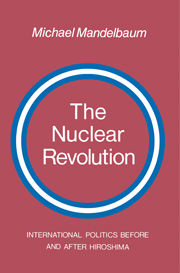Book contents
- Frontmatter
- Contents
- Preface
- 1 The nuclear revolution
- 2 Nuclear weapons and chemical and biological weapons
- 3 The balance of power in the nuclear age
- 4 Arms competition: The nuclear arms race and the Anglo–German naval rivalry
- 5 Arms competition: The nuclear arms race and tariff competitions
- 6 NATO: The nuclear alliance
- 7 The nuclear presidency
- 8 The bomb, dread, and eternity
- Notes
- Index
Preface
Published online by Cambridge University Press: 26 January 2010
- Frontmatter
- Contents
- Preface
- 1 The nuclear revolution
- 2 Nuclear weapons and chemical and biological weapons
- 3 The balance of power in the nuclear age
- 4 Arms competition: The nuclear arms race and the Anglo–German naval rivalry
- 5 Arms competition: The nuclear arms race and tariff competitions
- 6 NATO: The nuclear alliance
- 7 The nuclear presidency
- 8 The bomb, dread, and eternity
- Notes
- Index
Summary
This book addresses a single question: How have nuclear weapons affected international politics? It consists of an introduction, which sets out the framework for considering the question, and seven essays, each of which investigates the impact of these weapons of mass destruction on a particular aspect of relations among sovereign states. Because they revolve around the same question the essays have a common theme. They do not, however, form a single argument; the question does not have a single answer. Each of the essays can stand independently of the others, although all draw upon the general considerations outlined in the introductory chapter.
Each essay begins with a reference to Thucydides's account of the Peloponnesian War, to emphasize the fact that whatever else has changed since 1945 one thing remains the same: There is still a system of independent yet interdependent states of the sort that has existed since antiquity, a point that is elaborated in Chapter 1.
The book's approach is historical and comparative. I seek to answer its central question by discovering differences and similarities between the nuclear age and previous periods of international history. The last three and a half decades are not matched against the same period of prenuclear history in each chapter. Two of them, in fact, Chapters 2 and 5, do not involve comparisons across time at all, but between nuclear weapons and other kinds of armaments in the first case, and between nuclear weapons and a different form of international competition in the second.
- Type
- Chapter
- Information
- The Nuclear RevolutionInternational politics Before and after Hiroshima, pp. ix - xiiPublisher: Cambridge University PressPrint publication year: 1981

